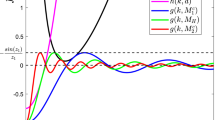Abstract
This paper investigates the dynamics of biomass in a marine ecosystem. A stochastic process is defined in which organisms undergo jumps in body size as they catch and eat smaller organisms. Using a systematic expansion of the master equation, we derive a deterministic equation for the macroscopic dynamics, which we call the deterministic jump-growth equation, and a linear Fokker–Planck equation for the stochastic fluctuations. The McKendrick–von Foerster equation, used in previous studies, is shown to be a first-order approximation, appropriate in equilibrium systems where predators are much larger than their prey. The model has a power-law steady state consistent with the approximate constancy of mass density in logarithmic intervals of body mass often observed in marine ecosystems. The behaviours of the stochastic process, the deterministic jump-growth equation, and the McKendrick–von Foerster equation are compared using numerical methods. The numerical analysis shows two classes of attractors: steady states and travelling waves.
Similar content being viewed by others
References
Aldous, D.J., 1999. Deterministic and stochastic models for coalescence (aggregation and coagulation): a review of the mean-field theory for probabilists. Bernoulli 5(1), 3–48.
Andersen, K.H., Beyer, J.E., 2006. Asymptotic size determines species abundance in the marine size spectrum. Am. Natur. 168, 54–61.
Andersen, K.H., Beyer, J.E., Lundberg, P., 2008. Trophic and individual efficiencies of size-structured communities. Proc. R. Soc., Ser. B 276, 109–114.
Anderson, C.N.K., Hsieh, C.-H., Sandin, S.A., Hewitt, R., Hollowed, A., Beddington, J., May, R.M., Sugihara, G., 2008. Why fishing magnifies fluctuations in abundance. Nature 452, 835–839.
Bardos, D.C., 2005. Probabilistic Gompertz model of irreversible growth. Bull. Math. Biol. 67, 529–545.
Benoît, E., Rochet, M.-J., 2004. A continuous model of biomass size spectra governed by predation and the effects of fishing on them. J. Theor. Biol. 226, 9–21.
Blanchard, J.L., Jennings, S., Law, R., Castle, M.D., McCloghrie, P., Rochet, M.-J., Benoît, E., 2009. How does abundance scale with body size in coupled size-structured food webs? J. Animal Ecol. 78, 270–280.
Boudreau, P.R., Dickie, L.M., 1992. Biomass spectra of aquatic ecosystems in relation to fisheries yield. Can. J. Fisheries Aquat. Sci. 49, 1528–1538.
Brown, J.H., Gillooly, J.F., Allen, A.P., Savage, V.M., West, G.B., 2004. Toward a metabolic theory of ecology. Ecology 85, 1771–1789.
Camacho, J., Solé, R.V., 2001. Scaling in ecological size spectra. Europhys. Lett. 55, 774–780.
Cohen, J.E., Pimm, S.L., Yodzis, P., Saldana, J., 1993. Body sizes of animal predators and animal prey in food webs. J. Animal Ecol. 62, 67–78.
Finkelshtein, D., Kondratiev, Y., Kutoviy, O., 2009. Individual based model with competition in spatial ecology. SIAM J. Math. Anal. 41(1), 297–317. arXiv:0803.3565.
Gillespie, D.T., 1976. A general method for numerically simulating the stochastic time evolution of coupled chemical reactions. J. Comput. Phys. 22, 403–434.
Gillespie, D.T., 2000. The chemical Langevin equation. J. Chem. Phys. 113, 297–306.
Gurney, W.S.C., Veitch, A.R., 2007. The dynamics of size-at-age variability. Bull. Math. Biol. 69, 861–885.
Heath, M.R., 1995. Size spectrum dynamics and the planktonic ecosystem of Loch Linnhe. ICES J. Marine Sci. 52, 627–642.
Hsieh, C.-H., Reiss, C.S., Hunter, J.R., Beddington, J.R., May, R.M., Sugihara, G., 2006. Fishing elevates variability in the abundance of exploited species. Nature 443, 859–862.
Jennings, S., Mackinson, S., 2003. Abundance-body mass relationships in size-structured food webs. Ecol. Lett. 6, 971–974.
Kerr, S.R., Dickie, L.M., 2001. The Biomass Spectrum: A Predator–Prey Theory of Aquatic Production. Columbia University Press, New York.
Law, R., Plank, M.J., James, A., Blanchard, J.L., 2009. Size-spectra dynamics from stochastic predation and growth of individuals. Ecology 90(3), 802–811.
Marquet, P.A., Quiñones, R.A., Abades, S., Labra, F., Tognelli, M., Arim, M., Rivadeneira, M., 2005. Scaling and power-laws in ecological systems. J. Exp. Biol. 208, 1749–1769.
Maury, O., Faugeras, B., Shin, Y.-J., Poggiale, C., Ari, T.B., Marsac, F., 2007. Modelling environmental effects on the size-structured energy flow through marine ecosystems. Part 1: The model. Prog. Oceanography 74, 479–499.
McKendrick, A.G., 1926. Applications of mathematics to medical problems. Proc. Edinb. Math. Soc. 40, 98–130.
Okubo, A., Levin, S.A., 2001. Diffusion and Ecological Problems, 2nd edn. Springer, New York.
Paloheimo, J.E., Dickie, L.M., 1966. Food and growth of fishes. III. Relations among food, body size, and growth efficiency. J. Fisheries Res. Board Can. 23, 1209–1248.
Pfister, C.A., Stevens, F.R., 2002. The genesis of size variability in plants and animals. Ecology 83, 59–72.
Platt, T., Denman, K., 1978. The structure of pelagic marine ecosystems. J. Conseil Int. l’Explor. Mer 173, 60–65.
Press, W.H., Teukolsky, S.A., Vetterling, W.T., Flannery, B.P., 1992. Numerical Recipes in C, 2nd edn. Cambridge University Press, Cambridge.
Sheldon, R.W., Prakash, A., Sutcliffe Jr., W.H., 1972. The size distribution of particles in the ocean. Limnology Oceanography 17, 327–340.
Sheldon, R.W., Sutcliffe, W.H., Paranjape, M.A., 1977. Structure of pelagic food chain and relationship between plankton and fish production. J. Fisheries Res. Board Can. 34, 2344–2353.
Shin, Y.-J., Cury, P., 2004. Using an individual-based model of fish assemblages to study the response of size spectra to changes in fishing. Can. J. Fisheries Aquat. Sci. 61, 414–431.
Silvert, W., Platt, T., 1978. Energy flux in the pelagic ecosystem: a time-dependent equation. Limnology Oceanography 23, 813–816.
Silvert, W., Platt, T., 1980. Dynamic energy-flow model of the particle size distribution in pelagic ecosystems. In: Kerfoot, W.C. (Ed.), Evolution and Ecology of Zooplankton Communities, pp. 754–763. University Press of New England, Hanover.
Smoluchowski, M., 1916. Drei Vorträge über Diffusion, Brownsche Bewegung und Koagulation von Kolloidteilchen. Phys Z. 17, 557–585.
van Kampen, N.G., 1992. Stochastic Processes in Physics and Chemistry. Elsevier Science, Amsterdam.
von Foerster, H., 1959. Some remarks on changing populations. In: Stohlman, J.F. (Ed.), The Kinetics of Cellular Proliferation, pp. 382–407. Grune and Stratton, New York
Ware, D.M., 1978. Bioenergetics of pelagic fish: theoretical change in swimming speed and ration with body size. J. Fisheries Res. Board Can. 35, 220–228.
Author information
Authors and Affiliations
Corresponding author
Rights and permissions
About this article
Cite this article
Datta, S., Delius, G.W. & Law, R. A Jump-Growth Model for Predator–Prey Dynamics: Derivation and Application to Marine Ecosystems. Bull. Math. Biol. 72, 1361–1382 (2010). https://doi.org/10.1007/s11538-009-9496-5
Received:
Accepted:
Published:
Issue Date:
DOI: https://doi.org/10.1007/s11538-009-9496-5




